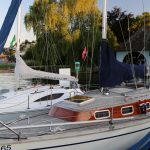 This was Richard’s Keynote to The European Travel Commission, presented on May 9, 2013. This also took first place in our 2013 travel writing competition.
This was Richard’s Keynote to The European Travel Commission, presented on May 9, 2013. This also took first place in our 2013 travel writing competition.
I once ran with the bulls of Pamplona….by mistake, involuntarily. I was at Microsoft, where we were developing a new travel product that would become Expedia, and we had the idea to use a new web technology called Live Chat to convey from the field the adventure of travel. I had the idea that I would cover the running of the bulls by standing in a doorway on the route of the stampede, and report live what was happening. But when the canon went off, a river of people charged down the street, and scooped me out of the doorway and into the fray. The 90 thousand people from around the world who tuned in to hear my reportage heard only screams as I ran with the bulls to the stadium.
Afterwards I checked out the bulletin boards that had the hundreds of photos taken by photographers on the balconies, and there were several sequences of a bull with his horn just inches from my back.
The experience was how some describe adventure today…a well-planned trip gone wrong….but it wasn’t always this way.
Europe is where Adventure Travel was born. Today it is a 150 billion dollar industry, and accounts for 26% of all tourism departures worldwide.
So, why do we take Adventure Travel Trips?
In 1735, the British poet Sir Hildebrand Jacob wrote “A mind truly disposed for the perceptions of that which is great and marvelous is a product of Nature and cannot be attained through study.” In other words, it’s good to get outdoors.
In 1757 The Irish philosopher Edmund Burke tried to account for the passions evoked in the human mind by what he called “terrible objects.” He was interested in our psychic response to things—a rushing cataract, a soaring cliff face, an avalanche—that seized, terrified, and yet also somehow pleased the mind by dint of being too big, too high, too fast, too powerful, too uncontrollable to be properly comprehended. These sights inspired a heady blend of pleasure and terror; these were the sights of Adventure. In Burke’s theory, beauty, which was about balance and grace, has a relaxing effect on the “fibers of the body,” whereas adventure tightens these same fibers. He wrote: “Whatever is fitted in any sort to excite the ideas of pain and danger, that is to say, whatever is in any sort terrible, is productive of the strongest emotion which the mind is capable of feeling.” He went on to posit that terror was a passion which “always produces delight when it does not press too close.” So, as in riding on a mountain train, or skiing a steep slope, kayaking a fast river or hiking through the wilderness it is the suggestion of harm, melded with the knowledge that no harm will likely come, which induces the sensation of delightful terror. It’s why we ride roller coasters, and why we take adventure-travel trips.
But it’s not just an elective. Adventure, which stimulates the evolution of consciousness, is necessary. As the English mathematician Alfred North Whitehead said, “Without adventure, civilization is in full decay.”
So, who were these first adventurers, and why?
Adventure was not a motivation for the first travelers through Europe. They were pilgrims, hunters, Crusaders heading for the Holy Land; mercenaries, messengers, tradesmen, smugglers and other criminals. Most of these voyagers avoided the “hills whose heads touch heaven,” afraid of the uncanny powers that lurked within. They did not want to be in the mountains of Europe; they did not want unnecessary adventure.
A half century before Christ the Romans considered the Alps inhospitable, desolate, hostile—…ocris, arduus, horridus. The Roman poet, Titus Lucretius Carus, called the Alps the waste places of the world, where Nature had swept its rubbish.
For generations after the Romans, mountains signified only the deformed and execrable, thinly soiled, steeply sloped, bad for farming, ordeals to cross, the lairs of demons and trolls. The Welsh priest Adam of Usk was so petrified when he crossed the Gotthard Pass in 1402 he had to be blindfolded, and travelers after him would often close the carriage curtains to avoid the dreadful scenes of the Alps. Anything could happen in this icy semi-circle of teeth that bit off Italy from the rest of Europe. Not only were the Alps scary; but they also were ugly, warts on the skin of the Earth; boils on its face. The classical notions of beauty called for purity, order, restraint, regularity, proportion—perfection; while The Alps were disordered, irregular, chaotic, and bad-mannered.
The monk John de Bremble was so horrified by his experience crossing the Great St. Bernard Pass that he prayed, “Lord restore me to my brethren, that I may tell them not to come to this place of torment.” Bishop Berkeley, crossing the Alps in 1714, carped that, “Every object that here presents itself is excessively miserable.”
Fantastic beliefs are not just a trait of modern politicians. In 1723, a Swiss Fellow of the Royal Society, Johann Jacob Scheuchzer, penned a famous “dracopedia” with detailed description of alpine dragons he had seen. And he believed that certain chamois possessed a stone in their bellies that rendered them immune to bullets.
And it wasn’t just the mountains that evoked these feelings. In 1791 the English cleric William Gilpin noted that “the generality of people found wilderness dislikable.” “There are few,” he wrote,” “who do not prefer the busy scenes of cultivation to the greatest of nature’s rough productions.” It’s interesting that if you look back before the 18th century there is virtually no literature that praises Grand Nature or the adventures found within…nothing in Virgil, Dante, Shakespeare or Milton…it’s all about the human form, about delicate beauty, about ordered gardens and symmetrical patterns. Unless a soldier, pilgrim or pirate, adventure was anathema.
So, how did this mindset change? When did they pull back the curtains?
In 1739, Cambridge professor Thomas Gray took the Grand Tour, crossed the Alps, and wrote letters in which he used the adjectives “romantic” and “poetic,” and the phrases, “a sacred terror” and “a severe delight.” With these words he put himself in a dramatic story, and turned the pages that grew a movement.
In 1775 Jean-Jacques Rousseau found his narrative voice and turned it on: “I must have torrents, rocks, pines, dead forest, mountains, rugged paths to go up and down, precipices beside to frighten me.”
Then the Industrial Revolution, which motivated record numbers to leave farms and crowd to the cities. Suddenly places like London were dirty, smoggy, disease and crime ridden—this was the setting that gave Charles Dickens his work. People lost faith in God and humanity.
But when the rock star Romantic poets… Lord Byron, Percy Shelly, Mary Shelly…who wrote Frankenstein …William Wordsworth, John Ruskin and others set out to adventure in the Alps, they found landscapes clean and green, dangerous and overwhelming, and it made them feel more alive, it made them believe in something powerful—and they called the feelings they evoked as
“An Agreeable Kind of Horror”
“A Magnificent Rudeness”
“A Rapturous Terror”
“A Turbulent Pleasure”
These were feelings on the other side of thought and language….this was adventure.
And it was one of the most profound revolutions in thought that ever occurred—the transition from a loathing of Grand Nature to its celebration.
And adventure travel was hatched.
The Compagnie des Guides de Chamonix was founded in 1821, and quickly became the biggest guide company in the world, attending to the thousands who followed in the footsteps of the Romantics.
Trains then democratized adventure. This despite early sentiments that the rapid movement of trains would cause brain damage and other ill-effects.
Thomas Cook—the Richard Branson of his day—helped prove those sentiments wrong. In 1855 he brought a tour group of 62 from England to the Continent for the first time, paving the way for cross sections of society to experience what had long been the province of the privileged. At last everyone could be a character is his own moving adventure play.
Cook wrote what is perhaps the best brochure copy ever. He said adventure travel “provides food for the mind; it contributes to the strength and enjoyment of the intellect; it helps pull men out of the mire and pollution of old corrupt customs; it promotes a feeling of universal brotherhood; it accelerates the march of peace and virtue, and love; it also contributes to the health of the body, by a relaxation from the toil and the invigoration of the physical powers.”
In 1888 French author Alphons Daudet wrote that “The ubiquitous impulse to leave the beaten track had been tapped and its fulfillment made available.” Europe was now ground zero for the exploding pike of adventure travel. And it remained so for over a century.
So, what then happened?
The rest of the world caught up, and in many ways took over what Europe started. The Himalaya took the climbers and trekkers; Africa poached the wildlife seekers; Latin America stole the romantics. Parts of Europe today are more American than America, yet with more rules.
But things are changing again, and herein lies the opportunity; to get back to where we once belonged.
In this age of GPS tracking, big data and disintermediation, adventure travel has become more and more analytical. More statistically driven; more about cost benefits analyses, about benchmarking; about safety, about quantifying guilt with tree plantings and pollution credits.
But the underlying enthusiasm for adventure remains the script with the participant as hero, the three act structure of challenge, struggle and resolution; the quest for the agreeable kind of horror Joseph Addison described in 1701. There is a fundamental delight in being close to danger. As someone who has spent some time exploring wild rivers in remote corners, and who holds the distinction of having capsized on six continents, I know this notion— that life is more intensely lived the closer one gets to its extinction. We never feel so alive as when we purl by the eddy of death.
Our impulses today remain as energetic as ever, eager for the romance, mystery and the vulnerability tapped in wild places….and these attributes argue for preservation, and visitation. Most people won’t be compelled to take an adventure because the lodge uses certain light bulbs or soap or low volume toilets; or hires locals; or carbon offsets, though these are necessary and good practices.
What most folks seek, I believe, are the unfathomable shadows where the wild things are. Our human DNA compels us to crave exploration, transformation, resonance, and a story that stars us.
Yet too many adventure experiences around the world have become internment centers mapped and planned with no blank spots. The trails are overly-marked and monitored; the buses video enabled, so you can watch the movie Brave rather than the castle outside the window. Around the world at pool sides and lobbies visitors watch from a safe distance ethnic spectacles and performances, loaded with Post-it Note mysticism. The deep, rich cultures and traditions are too often reduced to dinner shows for the mobile rich. In these brief, one-sided encounters, there is little chance to understand the people behind the dances, no real celebration of a vibrant, living culture. Visitors are offered the bread crumbs on the floor beneath the big table of cultural understanding.
In these dynamics, there is little room for true discovery; little prospect for a story that makes sense of who we are; little chance for profound adventure.
And there is little opportunity for magic and luck. The Danish Nobel Prize-winning physicist Niels Bohr, who nailed a horseshoe above his office door for good luck, was asked by a colleague, “You don’t really believe in this stuff, do you?” To which Bohr replied, “No, but I’ve heard it works even for people who don’t believe.”
Yes, the wilderness is vanishing, and cultures are fading, but what saves them are not dry statistics and doomsday scenarios, but rather the emotional sumptuousness and connection that comes from visitation. We have to lead from the heart, not the head. Our job is to figure out how to inspire someone on a couch in America or Asia watching his television or computer screen to get up and make that step and come see and feel the witchcraft of European wilderness. Once so touched, travelers become the most passionate advocates for place and preservation, as the trees and brooks and wild things are as family.
If pieces of Europe can be unmediatedly wild—like, for instance, Sutjeska National Park in Bosnia, where I recently got lost, afraid to go off path for fear of landmines …If pieces of Europe can be unmeadiately wild, without the requisite security and compliant spaces, without adult supervision, it is then faithful to our childlike imaginations of wilderness. The natural sublime is as much about awe as real danger…the peril of avalanches in the Alps; the risks of wild rivers in the Balkans; or the hazards of fjords in Norway. Real adventure attracts like moths to a flame, where we feel most alive when we can imagine our own demise.
Adventure ought to be the great, original quest, an individual tale of privation, courage, constant vigilance and danger. Done right, it is a journey undertaken with only a fragmentary map constructed out of a patchwork of accumulated local lore and the occasional milepost marked “here be dragons.”
If we decode adventure travel it fulfills the desire to find a new way of being, an experience unpredictable, immediate, and true. One of my favorite films is Michelangelo Antonioni’s The Passenger, in which Jack Nicholson plays a disillusioned journalist who decides to abandon his past and assume the role of a dead stranger. …The tale is a journey though landscapes of identity and mystery, shimmering with danger and uncertainty. And it occurs to me that any adventure travel trip is a similar chance for reinvention, for becoming someone different, perhaps someone better; a chance to explore the inaccessible landscapes and unmapped countries within each of us.
Yet the adventures of today, all over the world, have become too circumscribed. There is a powerful quality in being open-ended, vague at the borders; of being sufficiently unpolished that a visitor can expand upon it in his own mind, projecting himself into its narratives. Too many adventure providers today are like unctuous butlers of the imagination, ready to serve every need or desire as it arises; they don’t leave anything implied, unstated or incomplete. They don’t allow us to get lost.
The key here, of course, is akin to trundling on a train through the Alps..Europe today, unlike much of the world, can offer up the delight of the illusion of menace, the idea of danger, all with a comfortable seat and a nicely structured glass of wine. And it offers, as well, the adventures outside the train. Not many places can offer both.
This is the opportune moment for Europe. While economies stagger, tourism has never been more alluring, more important, for both the traveler and the destination. We can re-imagine, rebrand, and retrofit to bring back the thrills that once defined the continent. This is the time to let the chaos of adventure shimmer through the veil of order; to be open to tearing down the grid that has lidded the wild places, to peel back some rules, to strip the veneer of worldliness and return to some more primitive, if more demanding, state of grace, remembering, and perhaps retweeting, that Europe is where it all began.





Leave a Reply